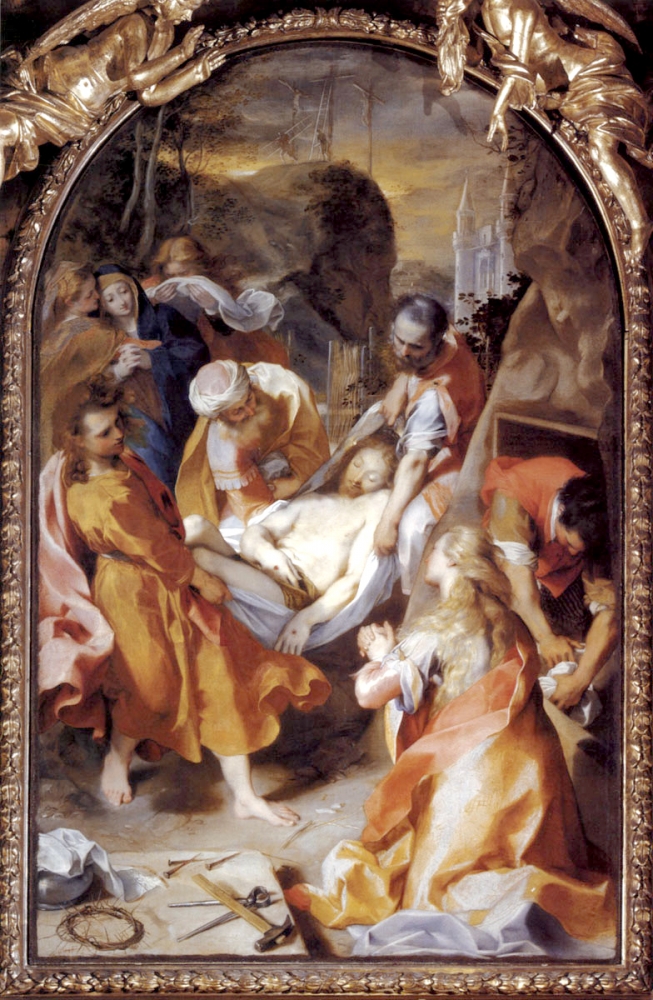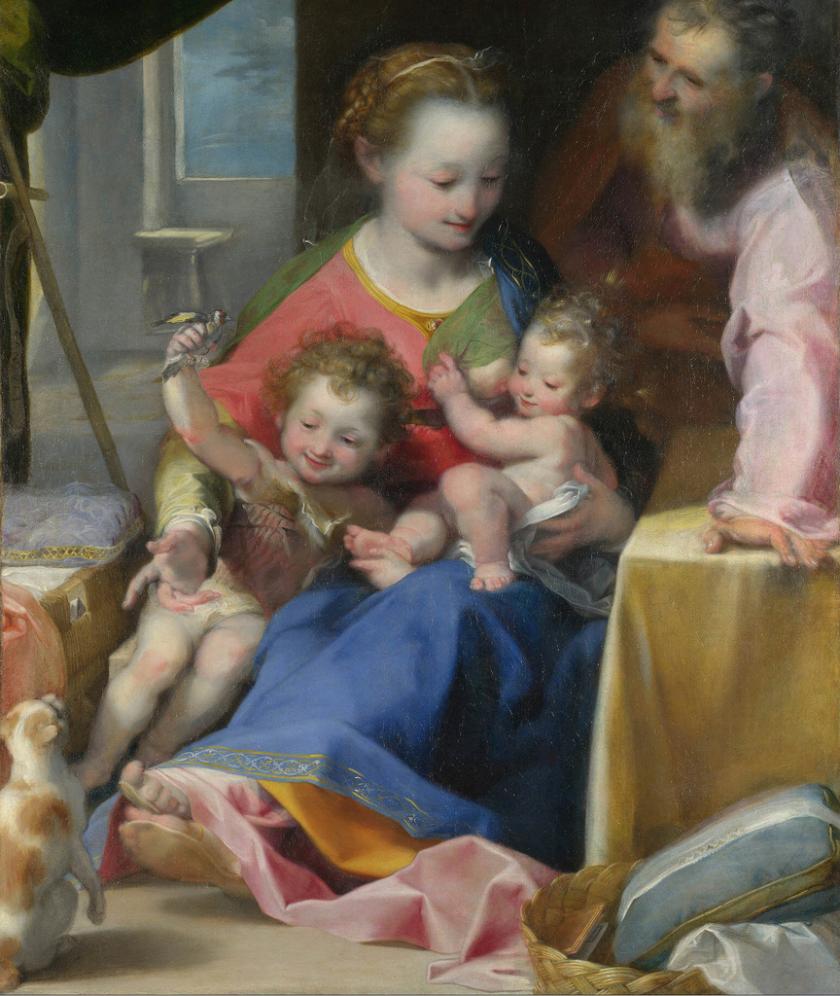Federico Barocci, who he? According to the National Gallery, a great Renaissance, mannerist and Baroque painter hardly known outside Italy, the National’s own Madonna of the Cat his only easel painting in a public collection in the UK. So while the Catholic church may be in turmoil, in central London there is a collection of images of colourful serenity, inspired by the Counter-Reformation of four centuries ago, and now appropriately resurrected for a contemporary audience. The show is a project over eight years in the making and for the gallery-going public, Barocci (c 1533-1612) is certainly a new boy outside Italy, for all his illustrious history.
This monographic exhibition devoted to the Urbino-based artist is an atmospheric display with most of the large paintings being shown outside their Italian host churches for the first time. The elaborate and crowded narratives focus on a handful of the major episodes of Christianity, from the Annunciation to the Deposition, and are accompanied by superbly fluent preparatory drawings and oil sketches and an incisive series of real-life portraits (The Entombment of Christ, below).
 Barocci's story is distinctly odd: he was an early success, gaining the attention of Michelangelo, but was reportedly poisoned by jealous peer-group painters when making his way in Rome, the city of choice for any ambitious artist of the period. He retreated back home to Urbino, with its healthier air and relative remoteness from the competitive atmosphere of Rome, although he still enjoyed papal patronage, and spent most of his devout life dedicated to making massive religious paintings with a surprisingly light and airy touch. He was commissioned by the Duke of Urbino among others: the ducal palace is glimpsed as background in several compositions.
Barocci's story is distinctly odd: he was an early success, gaining the attention of Michelangelo, but was reportedly poisoned by jealous peer-group painters when making his way in Rome, the city of choice for any ambitious artist of the period. He retreated back home to Urbino, with its healthier air and relative remoteness from the competitive atmosphere of Rome, although he still enjoyed papal patronage, and spent most of his devout life dedicated to making massive religious paintings with a surprisingly light and airy touch. He was commissioned by the Duke of Urbino among others: the ducal palace is glimpsed as background in several compositions.
His own self portrait, painted as he headed into his seventies, shows a prosperous but melancholic and even haunted face. His ill health dogged him and contributed to his working practices, which involved meticulous preparation in his magnificent drawings and a relatively small output of large scale paintings which required much more physical effort.
Yet these paintings are almost blindingly euphoric and optimistic; everyone is beautifully rounded, well muscled and well nourished. Even the crucified Christ is seemingly unperturbed by His suffering, while the Virgin is rosy-cheeked and rosy-lipped and even rosy-nippled. The Last Supper (below) is a crowd scene, for as well as the diners there's a host of athletic servants scrubbing pewter plates, while glasses and carafes containing water are brilliantly convincing. In The Visitation, the observant maidservant carries a basket of hens as she observes the pretty and pregnant Virgin Mary meeting her cousin St Elizabeth, pregnant with the future St John the Baptist, while St Joseph is accompanied by a donkey looking over his shoulder. A donkey also features in the Rest on the Return from Egypt, where Mary is the central figure, dipping her cup into a pond for refreshment. Barocci is enchanted by Mary throughout, and returns to her several times: she is eternally young, her skin glowing, eyes downcast, a dignified amalgam of innocence and modesty, but with a frisson of seductive charm.
 The actors in these elaborate set pieces are based on both observing ordinary people and hiring them as models, yet by the time they appear as saints they are idealised, almost irritatingly so, and framed by angels. But there can be a subtle wit: the complex Madonna of the Cat shows us an alert young tortoiseshell cat gazing hungrily up at the finch clutched in the baby St John the Baptist’s hand. We can almost hear the anticipatory purr. The luxuriously costumed Holy Family is nicely situated in a Renaissance palace; Mary’s delicately rounded pink nippled right breast is on offer to her child. And could his portrait of Francisco Maria II della Rovere, a warrior in his prime, a successful soldier in the Battle of Lepanto, a relative of popes, a ruler of Urbino, be completely straight-faced? His garb is conspicuously consumerist, encased as he is with ceremonial armour, sashed in red and gold with even the plumes on his helmet seriously exuberant.
The actors in these elaborate set pieces are based on both observing ordinary people and hiring them as models, yet by the time they appear as saints they are idealised, almost irritatingly so, and framed by angels. But there can be a subtle wit: the complex Madonna of the Cat shows us an alert young tortoiseshell cat gazing hungrily up at the finch clutched in the baby St John the Baptist’s hand. We can almost hear the anticipatory purr. The luxuriously costumed Holy Family is nicely situated in a Renaissance palace; Mary’s delicately rounded pink nippled right breast is on offer to her child. And could his portrait of Francisco Maria II della Rovere, a warrior in his prime, a successful soldier in the Battle of Lepanto, a relative of popes, a ruler of Urbino, be completely straight-faced? His garb is conspicuously consumerist, encased as he is with ceremonial armour, sashed in red and gold with even the plumes on his helmet seriously exuberant.
Especially memorable is the wonderful range of glowing, incandescent colour in the great set pieces, the acid yellows and greens anticipating Poussin’s memorable Roman palette a century later. Textured draperies and costumes shine in an array of blues, lilacs, whites, reds, pinks: even the martyrs are cheerful, and the light-filled skies are an antidote to London's winter greys.
At the National Gallery until 19 May









![SEX MONEY RACE RELIGION [2016] by Gilbert and George. Installation shot of Gilbert & George 21ST CENTURY PICTURES Hayward Gallery](/sites/default/files/styles/thumbnail_125_x_125_/public/mastimages/Gilbert%20%26%20George_%2021ST%20CENTURY%20PICTURES.%20SEX%20MONEY%20RACE%20RELIGION%20%5B2016%5D.%20Photo_%20Mark%20Blower.%20Courtesy%20of%20the%20Gilbert%20%26%20George%20and%20the%20Hayward%20Gallery._0.jpg?itok=3oW-Y84i)





Add comment